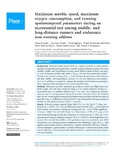Maximum aerobic speed, maximum oxygen consumption, and running spatiotemporal parameters during an incremental test among middle- and long-distance runners and endurance non-running athletes

Use este enlace para citar
http://hdl.handle.net/2183/32300Colecciones
- Investigación (CCDEF) [297]
Metadatos
Mostrar el registro completo del ítemTítulo
Maximum aerobic speed, maximum oxygen consumption, and running spatiotemporal parameters during an incremental test among middle- and long-distance runners and endurance non-running athletesAutor(es)
Fecha
2022-10-05Cita bibliográfica
Casado A, Tuimil JL, Iglesias X, Fernández-del-Olmo M, Jiménez-Reyes P, Martín-Acero R, Rodríguez FA. 2022. Maximum aerobic speed, maximum oxygen consumption, and running spatiotemporal parameters during an incremental test among middle- and long-distance runners and endurance non-running athletes. PeerJ 10:e14035 https://doi.org/10.7717/peerj.14035
Resumen
[Abstract] Background. Maximal aerobic speed (MAS) is a useful parameter to assess aerobic
capacity and estimate training intensity in middle- and long-distance runners. However,
whether middle- and long-distance runners reach different levels of MAS compared
to other endurance athletes with similar VO˙
2max has not been previously studied.
Therefore, we aimed to compare VO˙
2max, MAS and spatiotemporal parameters between
sub-elite middle- and long-distance runners (n = 6) and endurance non-runners
(n = 6). In addition, we aimed to compare the maximal blood lactate concentration
[BLa] experienced by participants after conducting these tests.
Methods. Telemetric portable respiratory gas analysis, contact and flight time, and
stride length and rate were measured using a 5-m contact platform during an
incremental test at a synthetic athletics track. VO˙
2, heart rate, respiratory quotient
values in any 15 s average period during the test were measured. [BLa] was analyzed
after the test . Running spatiotemporal parameters were recorded at the last two steps of
each 400 m lap. A coefficient of variation (%CV) was calculated for each spatiotemporal
variable in each participant from 8 km h−1 onwards.
Results. Whereas runners reported faster MAS (21.0 vs. 18.2 km h−1
) than nonrunners (p = 0.0001, ES = 3.0), no differences were found for VO˙
2max and maximum
blood lactate concentration during the running tests (p > 0.05). While significant
increases in flight time and stride length and frequency (p < 0.001, 0.52 ≤ η
2
p ≤ 0.8)
were observed throughout the tests, decreases in contact time (p < 0.001, η
2
p = 0.9)
were reported. Runners displayed a greater %CV (p = 0.015) in stride length than nonrunners. We conclude that middle- and long-distance runners can achieve a faster MAS
compared to non-running endurance athletes despite exhibiting a similar VO˙
2max. This
superior performance may be associated to a greater mechanical efficiency. Overall,
runners displayed a greater ability to modify stride length to achieve fast speeds, which
may be related to a more mechanically efficient pattern of spatiotemporal parameters
than non-runners.
Palabras clave
Kinesiology
Respiratory Medicine
Biomechanics
Sports Medicine
Maximal oxygen uptake
Performance
Maximal aerobic speed
Running
Spatiotemporal parameters
Respiratory Medicine
Biomechanics
Sports Medicine
Maximal oxygen uptake
Performance
Maximal aerobic speed
Running
Spatiotemporal parameters
Versión del editor
Derechos
Atribución 3.0 España
ISSN
2167-8359






